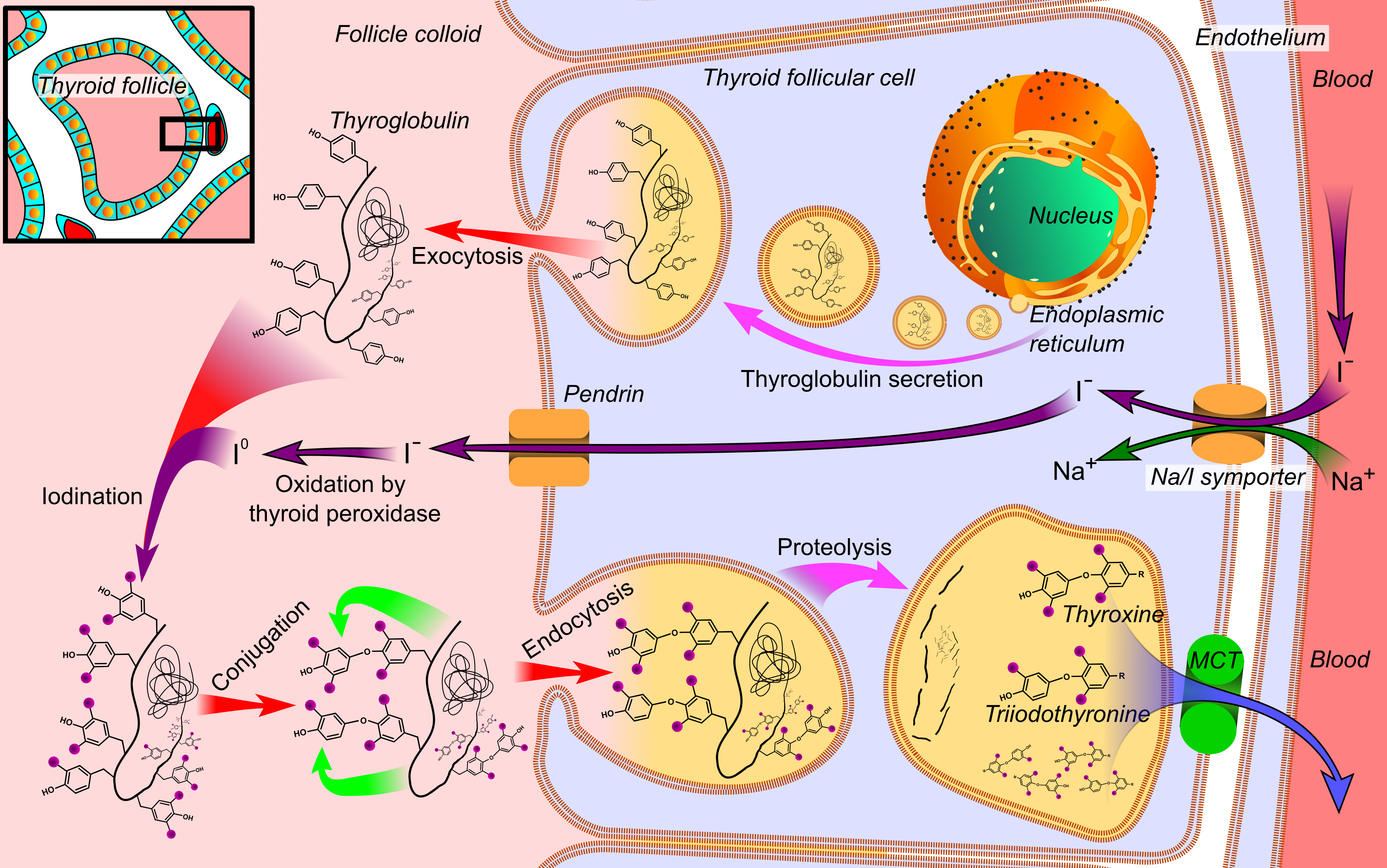Thyroid Epithelial Cell on:
[Wikipedia]
[Google]
[Amazon]
Thyroid follicular cells (also called thyroid epithelial cells or thyrocytes) are the major cell type in the thyroid gland, and are responsible for the production and secretion of the thyroid hormones
 Follicular cells take up iodide and
Follicular cells take up iodide and
thyroxine
File:Thyroid_system.svg, upright=1.5, The thyroid system of the thyroid hormones T3 and T4
rect 376 268 820 433 Thyroid-stimulating hormone
rect 411 200 849 266 Thyrotropin-releasing hormone
rect 297 168 502 200 Hypothalamus
rect 66 216 38 ...
(T4) and triiodothyronine
Triiodothyronine, also known as T3, is a thyroid hormone. It affects almost every physiological process in the body, including growth and development, metabolism, body temperature, and heart rate.
Production of T3 and its prohormone thyrox ...
(T3). They form the single layer of cuboidal epithelium
Epithelium or epithelial tissue is one of the four basic types of animal tissue, along with connective tissue, muscle tissue and nervous tissue. It is a thin, continuous, protective layer of compactly packed cells with a little intercellu ...
that makes up the outer structure of the almost spherical thyroid follicle.
Structure
Location
Thyroid follicular cells form a simplecuboidal epithelium
Epithelium or epithelial tissue is one of the four basic types of animal tissue, along with connective tissue, muscle tissue and nervous tissue. It is a thin, continuous, protective layer of compactly packed cells with a little intercellu ...
and are arranged in spherical thyroid follicles surrounding a fluid filled space known as the colloid. The interior space formed by the follicular cells is known as the follicular lumen. The basolateral membrane of follicular cells contains thyrotropin receptors which bind to thyroid-stimulating hormone
Thyroid-stimulating hormone (also known as thyrotropin, thyrotropic hormone, or abbreviated TSH) is a pituitary hormone that stimulates the thyroid gland to produce thyroxine (T4), and then triiodothyronine (T3) which stimulates the metabolis ...
(TSH) found circulating in the blood.
Calcitonin
Calcitonin is a 32 amino acid peptide hormone secreted by parafollicular cells (also known as C cells) of the thyroid (or endostyle) in humans and other chordates. in the ultimopharyngeal body. It acts to reduce blood calcium (Ca2+), opposing ...
-producing parafollicular cell
Parafollicular cells, also called C cells, are neuroendocrine cells in the thyroid. The primary function of these cells is to secrete calcitonin. They are located adjacent to the thyroid follicles and reside in the connective tissue. These cells a ...
s are also found along the basement membrane
The basement membrane is a thin, pliable sheet-like type of extracellular matrix that provides cell and tissue support and acts as a platform for complex signalling. The basement membrane sits between epithelial tissues including mesothelium and ...
of the thyroid follicle, interspersed between follicular cells; and in spaces between the spherical follicles. Parafollicular cells can be distinguished from follicular cells based on their lighter staining cytoplasm using H&E.
Development
Their embryologic origin is from a median endodermal mass in the region of the tongue (foramen cecum) in contrast to parafollicular cells which arise from the 4th pharyngeal pouch.Function
 Follicular cells take up iodide and
Follicular cells take up iodide and amino acid
Amino acids are organic compounds that contain both amino and carboxylic acid functional groups. Although hundreds of amino acids exist in nature, by far the most important are the alpha-amino acids, which comprise proteins. Only 22 alpha ...
s from the blood circulation
The blood circulatory system is a system of organs that includes the heart, blood vessels, and blood which is circulated throughout the entire body of a human or other vertebrate. It includes the cardiovascular system, or vascular system, tha ...
on the basolateral side, synthesize thyroglobulin and thyroperoxidase from amino acids and secrete these into the thyroid follicles together with iodide. The follicular cells subsequently take up iodinated thyroglobulin from the follicles by endocytosis
Endocytosis is a cellular process in which substances are brought into the cell. The material to be internalized is surrounded by an area of cell membrane, which then buds off inside the cell to form a vesicle containing the ingested material. E ...
, extract thyroid hormones from it with the help of protease
A protease (also called a peptidase, proteinase, or proteolytic enzyme) is an enzyme that catalyzes (increases reaction rate or "speeds up") proteolysis, breaking down proteins into smaller polypeptides or single amino acids, and spurring the form ...
s and subsequently release thyroid hormones into the blood.
These thyroid hormones are transported throughout the body where they control metabolism (which is the conversion of oxygen and carbohydrates to energy). Every cell in the body depends upon thyroid hormones for regulation of their metabolism. The normal thyroid gland produces about 80% T4 and about 20% T3, however, T3 is about four times as potent as T4.
Iodide transport
The transport of iodide into follicular cells is vital for the synthesis of theiodine
Iodine is a chemical element with the Symbol (chemistry), symbol I and atomic number 53. The heaviest of the stable halogens, it exists as a semi-lustrous, non-metallic solid at standard conditions that melts to form a deep violet liquid at , ...
containing thyroid hormones. Iodide is actively transported at the basolateral membrane of follicular cells by the sodium-iodide symporter. At the apical membrane iodide is secreted into the colloid by the chloride/iodide transporter pendrin.
See also
* Thyroid diverticulum * List of human cell types derived from the germ layersReferences
External links
* * {{Authority control Endocrine cells Human cells Thyroid